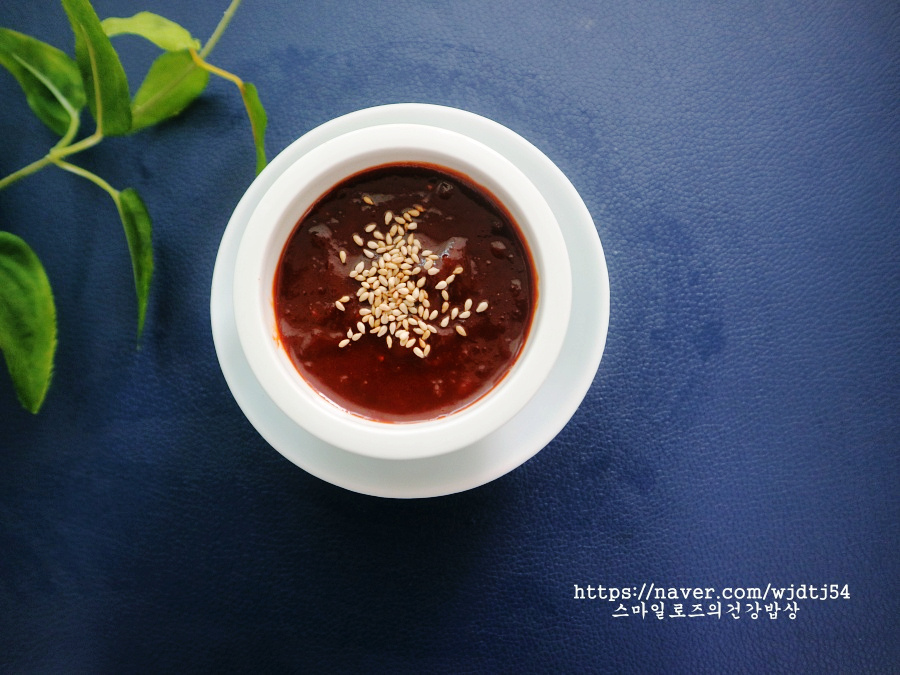Tangy & Sweet Gochujang Sauce
Easy Homemade Gochujang Sauce Recipe: Better Than Store-Bought

On hot days, we crave refreshing and zesty dishes! Gochujang sauce is the perfect accompaniment to seafood and fresh vegetables. Make your own at home for a taste that rivals, and often surpasses, store-bought versions. While the base is gochujang, vinegar, and sugar, adding ingredients like plum extract or cider can create a richer, more complex flavor. Let’s get started on this simple yet deeply flavorful homemade gochujang sauce recipe!
Basic Ingredients- 3 Tbsp Gochujang (Korean chili paste)
- 1 Tbsp Sugar
- 0.3 Tbsp Minced Garlic (approx. 1/3 Tbsp)
- 1 Tbsp Vinegar
- 1 Tbsp Plum Extract (Maesilcheong)
- 2 pinches Ground Ginger
- 0.5 Tbsp Horseradish (Wasabi)
- 1 Tbsp Unsweetened Cider
- A little Toasted Sesame Seeds
Cooking Instructions
Step 1
While store-bought gochujang sauce typically has a shelf life of 1 to 1.5 years from the manufacturing date, it’s best to consume it within 1 month after opening when refrigerated. Making it at home in small batches ensures freshness and eliminates concerns about leftovers. Gochujang sauce is commonly served with raw fish and seafood. It’s relatively high in calories, around 215 kcal per 100g. If you’re dieting, it’s advisable to avoid sauces, but if you can’t sacrifice flavor, consider using homemade low-calorie options. Today, we’ll be making a gochujang sauce to pair with fresh broccoli. Let’s begin this simple yet delicious sauce-making journey!

Step 2
In the past, people used to make their own gochujang, doenjang, and soy sauce, but nowadays, pre-made products are very convenient. I’ve prepared store-bought gochujang for this recipe. The secret to an easy and delicious gochujang sauce lies in a simple ratio: Gochujang: Sugar: Vinegar = 3:1:1. Adding a few extra ingredients to this base will create a flavor far superior to anything store-bought! First, in a bowl, combine 3 tablespoons of gochujang, 1 tablespoon of sugar, and 0.3 tablespoons of minced garlic. Mix them well.

Step 3
Next, add 2 pinches of ground ginger, 1 tablespoon of plum extract, and 1 tablespoon of unsweetened cider. The plum extract adds sweetness and aroma, while the cider contributes a clean, refreshing sweetness, making the sauce even more vibrant.

Step 4
Finally, add 0.5 tablespoons of horseradish (wasabi) and mix all the ingredients thoroughly until the sugar is well dissolved. Your delicious gochujang sauce is ready! The amount of horseradish can be adjusted to your preference or omitted entirely. I personally enjoy the spicy kick it provides.

Step 5
While you can enjoy it immediately, letting the sauce rest in the refrigerator for 1-2 days allows the flavors to meld and deepen, resulting in a richer umami taste. Once complete, transfer the sauce to a serving dish and sprinkle with toasted sesame seeds for a refreshing and zesty gochujang sauce with a pleasant kick.

Step 6
This tangy, sweet, aromatic, and slightly spicy gochujang sauce is a perfect match not only for vegetables like broccoli but also for fresh seafood dishes. You could even make a delicious seasoned squid salad (ojingeo muchim) using squid from your freezer and various vegetables. Enjoy a taste worthy of a Japanese restaurant right in your own kitchen!

Step 7
No more worrying about expiration dates on store-bought gochujang sauce! Make your own homemade version and use it in a variety of refreshing summer dishes. Using this simple yet flavorful recipe, you can create a more abundant and delicious dining experience this summer!



